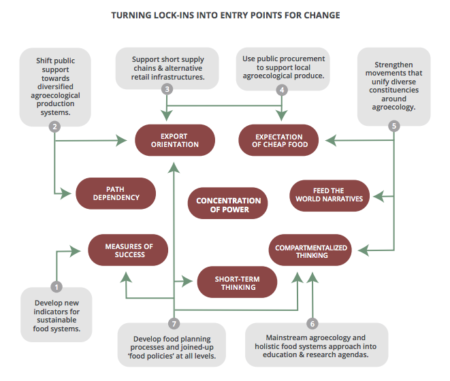The International Panel of Experts on Sustainable Food Systems (IPES-Food), led by Olivier De Schutter, former UN Special Rapporteur on the right to food, released its findings today in a report entitled ‘From Uniformity to Diversity: A paradigm shift from industrial agriculture to diversified agroecological systems.’ The report was launched at the Trondheim Biodiversity Conference (Norway) by lead author Emile Frison, former Director General of Bioversity International.
I guess you all saw that last week. There’s an executive summary. And key messages. If you don’t have the time to wade through the 100 pages of the full report. But actually the message can be summarized even further: agroecology, everywhere. And there’s a handy diagram for how to get us there:
And even that can be summarized. It’s all down to the right indicators, getting away from the tyranny of kilograms of cereals per unit land area. Measure things that are more important to people, and in ways that take proper account of sustainability, and you can’t help but produce a shift to agroecological production, the report seems to suggest.
Which is of course something we have occasionally suggested here. Well, at least the first part of that statement is something we’ve said. Not least in the context of the Sustainable Development Goals. Which reminds me to link to CIAT’s latest policy brief on progress towards defining indicators for Target 2.5, also out last week.
As the SDGs, CBD Strategic Plan for Biodiversity, and other global agreements struggle to find tangible indicators for achieving their stated targets, we propose that the results of our global analysis of crop wild relatives can be directly used to assess the current state of conservation of these wild species ex situ. Moreover, the methods used in the “gap analysis” can be adapted for assessments of crop landraces and livestock breeds. Furthermore, the tools can be used iteratively to assess progress over time.
There’s nothing in the IPES report on the SDGs in general (which I found strange, but anyway), let alone Target 2.5 specifically, but I am somewhat heartened by this passage (p. 71):
Support for diversity fairs, community genebanks and seed banks is likely to be a crucial element in strengthening social movements and unifying them around diversified, agroecological systems.
It could, I suppose be read as excluding “formal” genebanks from the equation, but I choose to interpret it as saying that national and international genebanks need to work together with community-level efforts to conserve and use crop diversity. Which I’d buy even if the calculus did not lead inexorably to agroecology, everywhere.
